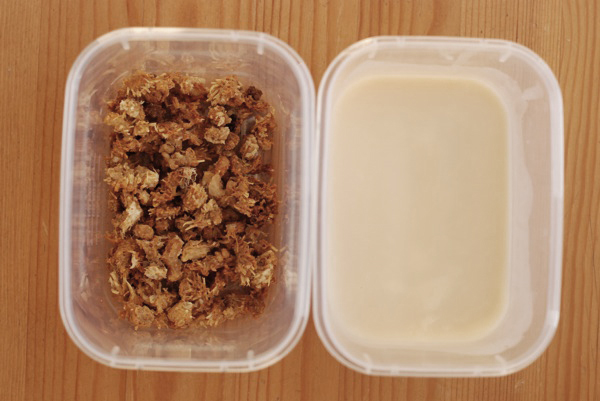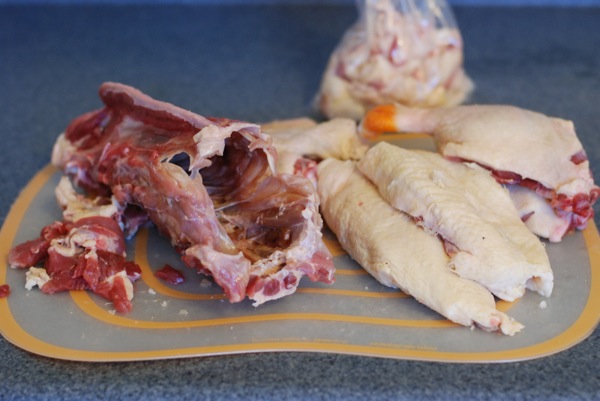 Among my mildest marital disputes is a debate over poultry of choice. She likes chicken; I like duck. I suppose that's not surprising, since m'lady loves straightforward food that doesn't keep me in the kitchen for long hours, and I...well, I love long hours in the kitchen. For months, I've been all talk about making duck. Not least because it's on my kitchen resolutions list, I thought it'd finally be nice to learn how to make duck confit, which I love; duck fat, which makes french fries sing; duck cracklings, which transform a salad or a lazy afternoon; and duck prosciutto, which remains on my list of to-dos, but will have to wait for another time.
Among my mildest marital disputes is a debate over poultry of choice. She likes chicken; I like duck. I suppose that's not surprising, since m'lady loves straightforward food that doesn't keep me in the kitchen for long hours, and I...well, I love long hours in the kitchen. For months, I've been all talk about making duck. Not least because it's on my kitchen resolutions list, I thought it'd finally be nice to learn how to make duck confit, which I love; duck fat, which makes french fries sing; duck cracklings, which transform a salad or a lazy afternoon; and duck prosciutto, which remains on my list of to-dos, but will have to wait for another time.
A few stars aligned that pushed me to do this, and do it now. First, my friend Cathy has launched Charcutepalooza, and I had to join the fun. Be sure to check it out. Second, the kind folks at KOL Foods sent over a beautiful, pasture-raised duck, so I knew it was time to put my knife skills where my mouth is.
That's when the fear set in. What if I mess up? What if all the wonderful duck meat and fat and skin and bones don't wind up in all sorts of deliciousness? I needed to start small.
They say start with the outside and work your way in. So that's exactly what I did. I started on the outside -- literally: with the skin.
The deal with skin is simple. It's part fat, part solids, part water. Apply heat, and all the parts separate. Fat renders, solids crisp up, water evaporates.
There are two different ways to render skin. One is to just drop the pieces of skin into the pan, let them sizzle away, and be ready with a spoon to scoop that fat off the heat as soon as it liquefies. Sounds annoying, doesn't it? That's why we used method number 2, rendering the skin in water. Adding a bit of water to the pan ensures the surface temperature can't rise above 212 degrees, so the fat renders gradually and doesn't burn. If you do it right, the water evaporates completely just in time for the fat to all have rendered and the cracklings to crisp up. It's a pretty magical process.
Having done this twice, I'm now the proud mama of 2 cups of duck fat, and those cracklings were effin' amazing. If you stay tuned for Cook a Duck Part 2, you'll see just what I did with that duck fat. I can promise it won't disappoint.
And not to get ahead of myself, but Duck Part 3 is already in the works. Let's just say I wouldn't be surprised if the mild marital dispute I mentioned earlier was put to rest, forever. And yours truly was crowned the winner.
How to Render Duck Fat
Note: the timing of this recipe depends entirely on the size of your pan. I used a little saucepan, but if you use a wider shallower pan, it'll take less time. Up to you.
1 pound of skin 1/4 cup water
Add skin and water to a pan and set over medium heat. When water is simmering, reduce heat to medium-low. Maintain a low simmer, and watch the fat slowly render and the water slowly evaporate. The whole process takes about an hour, maybe a bit more.
Keep an eye on it in the beginning to make sure the simmer isn't too rapid, and be sure to have a splatter screen or a tinfoil tent ready toward the end, because it may splatter once there are only a few drops of water left.
When the splattering subsides, the cracklings are brown, and the fat is clear and liquid, you're done. Scoop out the cracklings with a slotted spoon and transfer to a paper towel-lined plate. Sprinkle with salt and eat. Strain the fat through a cheese cloth-lined strainer (in a pinch, a fine mesh strainer alone will do). Chilled fat will keep in an airtight container for months in the fridge.
